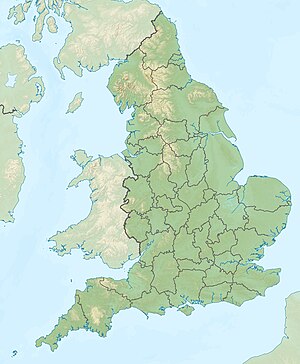Windermere
| Windermere | ||
|---|---|---|

|
||
| Windermere seen from the north | ||
| Geographical location | Lake District , Cumbria , England | |
| Tributaries |
Brathay , Rothay , Trout Beck , Cunsey Beck , Blelham Beck , Ghyll Head Beck , Mill Beck , Hol Beck |
|
| Drain | Leven | |
| Places on the shore | Ambleside , Bowness-on-Windermere | |
| Data | ||
| Coordinates | 54 ° 21 ′ N , 2 ° 56 ′ W | |
|
|
||
| Altitude above sea level | 40 m ASL | |
| surface | 14.73 km² | |
| length | 17 km | |
| width | 1.5 km | |
| Maximum depth | 65 m | |
|
particularities |
largest natural lake in England |
|
The Windermere is the largest lake in England . It lies completely in the Lake District - National Park in the county of Cumbria . The lake and its surroundings have been one of the most popular holiday destinations in England since the railway line between Kendal and the village of Windermere was completed in 1847 .
geography
The Windermere is 17 km long and between 400 and 1500 m wide. The deepest point of the Windermere is 65 m at its northern end. The lake is located at a height of 40 m above sea level . The water of the Windermere drains into the River Leven at its southernmost point . The tributaries of the lake are the Brathay , Rothay , Trout Beck , Cunsey Beck, and several smaller streams.
There are eighteen islands in Windermere, the largest of which is about a kilometer long.
On the banks of the Windermere are the two towns of Ambleside and Bowness-on-Windermere . The town of Windermere , on the other hand, is not located directly on the shore of the lake. It only got its name after the completion of the railway line and was previously known as Birthwaite. From Windermere, the lakeshore is around 15 minutes' walk away. In the meantime, Windermere has largely grown together with Bowness. Windermere, with its train station and other transport facilities, is the transport hub for the surrounding area. B. exist to Manchester .
The landscape around the lake consists mainly of small hills, which are ideal for hikes with little difficulty. The higher mountains ( fells ) of the Cumbrian Mountains extend mainly to the north and east.
Natural history
A large proportion of the adjacent areas on the lake are used for agriculture (29.4%). The lake is mostly shallow - only 28% of the lake is deeper than 9 m. This makes the lake a nutrient-rich habitat. The predominant fish species are trout, char, pike and perch. Due to its pronounced north-south orientation and its location between Morecambe Bay and the Central Fells , the area around the lake plays an important role on the flight paths of migratory birds. Wild geese visit the area regularly in the winter months. The Freshwater Biological Association was founded on the banks of the Windermere in 1929, and basic knowledge of ecology , freshwater biology and limnology was gained here.
Recovery camp for Holocaust survivors
In the summer of 1945, 300 children and young people, all of them survivors of the German concentration camps and displaced persons , were brought to the Lake District. They were deeply traumatized and the idyllic landscape should help them find their way back to a normal life. About the camp reported u. a. the historian Martin Gilbert . The Fate of the Children was made into a film under the title The Children of Windermere .
various
Racing drivers Henry Segrave and Norman Buckley set several world speed records on the water on Windermere in the 1930s and 1950s, respectively . A car ferry operates a route between Bowness on the east bank and Far Sawrey on the west bank of the lake.
After many years of speed boating and water skiing were among the most popular sports on the lake, in 2000 the administration of the national park set a maximum speed for ships on the lake of 11 knots (approx. 18.5 km / h). Compliance with this regulation has also been followed in practice since March 29, 2005. This step is welcomed by many, as it is a way back to the calm nature of the lake and at the same time the lake becomes more attractive for more visitors. Opponents of the speed restrictions, especially those practicing the abovementioned sports, complain about the lack of inland waters to continue their sport.
The lake is one of the few in the country with noticeable tides .
See also
Web links
- Lake Windermere - an Illustrated Guide
- The Children of Windermere - TV film and documentary, ZDF 2020
Individual evidence
- ^ Joe Shute, From the Holocaust to Lake Windermere
- ↑ They were the boys. The story of 732 young Holocaust survivors , Verlag für Berlin-Brandenburg, Berlin, 2007, ISBN 978-386650-222-2 .

